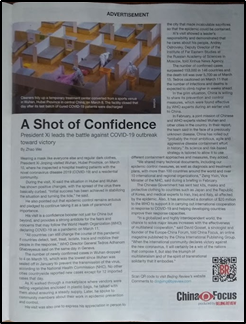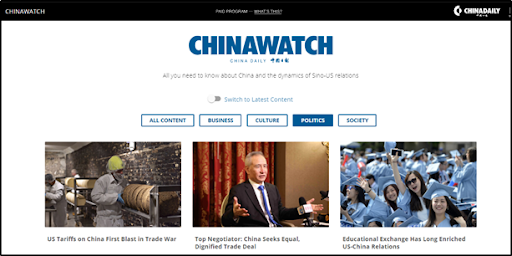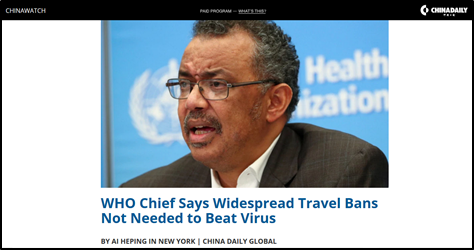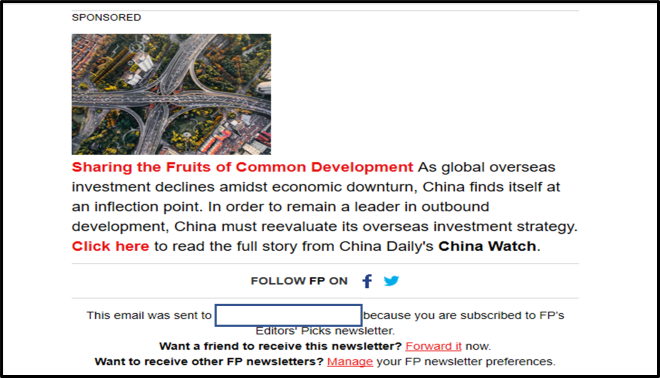By: John Dotson
Introduction
For many years, the People’s Republic of China (PRC)’s state propaganda apparatus has sought to expand its influence among foreign audiences as part of a broader effort to achieve greater “discourse power” (话语权, huayuquan) for the Chinese Communist Party (CCP) internationally (CACR, December 15, 2020). One component of this effort has been the practice of “borrowing foreign newspapers” (借用海外报刊, jieyong haiwai baokan) to promote Beijing’s preferred messages—a practice pursued both through the cultivation of foreign reporters and media figures, as well as through the direct purchase of “advertorial” inserts in influential international newspapers and magazines.[1] More recently, this practice has also moved into the realm of online media, with the PRC’s state-run Xinhua News Agency sponsoring propaganda content for publication in the websites of foreign newspapers and magazines. The long-standing practice of hardcopy “advertorial” publishing has moved into the electronic realm.
Xinhua “Advertorial” Inserts in Print Media
A long history exists of PRC state media outlets paying for “advertorial” inserts into major U.S. newspapers such as the Washington Post, Wall Street Journal and New York Times—often under the banners of “China Watch” or “China Focus,” which are both headings used by Xinhua for its English-language content (see accompanying images) (Freedom House, 2020). The articles in these inserts are intended to look like news and editorial material presented by the host newspaper (albeit accompanied by disclaimers, often in small print), but represent propaganda content prepared by the CCP’s foreign media apparatus.
Significant outlays are involved in the purchase of these advertorial inserts. For example, inquiries in 2011 by Congressional staff indicated that the cost of a China Watch insert in the Washington Post was $300,000 dollars at that time, excluding additional fees for web-based content, and reporting from 2016 indicated that the U.K.-based Daily Telegraph collected £750,000 annually (over $1 million dollars) to publish similar inserts.[2] Widespread criticism has led some publications to reconsider the practice: for example, in 2020 Daily Telegraph and a handful of Australian newspapers (including the Sydney Morning Herald and The Age) announced that they would no longer carry such inserts (The Guardian, April 14, 2020 and December 8, 2020).
 Image: (Left) The front page of a four-page “advertorial” insert in the Des Moines Register in September 2018 (Des Moines Register, Sep. 24, 2018). (Right) A full-page “advertorial” advertisement in the March 21, 2020 print edition of The Economist, titled “A Shot of Confidence—President Xi Leads the Battle Against COVID-19 Outbreak,” which praised the Chinese government for “the most ambitious, agile, and aggressive disease containment effort in history,” and held China’s response up as a model to the world. (Source: Author’s photo)
Image: (Left) The front page of a four-page “advertorial” insert in the Des Moines Register in September 2018 (Des Moines Register, Sep. 24, 2018). (Right) A full-page “advertorial” advertisement in the March 21, 2020 print edition of The Economist, titled “A Shot of Confidence—President Xi Leads the Battle Against COVID-19 Outbreak,” which praised the Chinese government for “the most ambitious, agile, and aggressive disease containment effort in history,” and held China’s response up as a model to the world. (Source: Author’s photo)

 Image: (Left) The front page of a four-page “advertorial” insert in the Des Moines Register in September 2018 (Des Moines Register, Sep. 24, 2018). (Right) A full-page “advertorial” advertisement in the March 21, 2020 print edition of The Economist, titled “A Shot of Confidence—President Xi Leads the Battle Against COVID-19 Outbreak,” which praised the Chinese government for “the most ambitious, agile, and aggressive disease containment effort in history,” and held China’s response up as a model to the world. (Source: Author’s photo)
Image: (Left) The front page of a four-page “advertorial” insert in the Des Moines Register in September 2018 (Des Moines Register, Sep. 24, 2018). (Right) A full-page “advertorial” advertisement in the March 21, 2020 print edition of The Economist, titled “A Shot of Confidence—President Xi Leads the Battle Against COVID-19 Outbreak,” which praised the Chinese government for “the most ambitious, agile, and aggressive disease containment effort in history,” and held China’s response up as a model to the world. (Source: Author’s photo)Xinhua Advertorial Content Goes Digital
While Xinhua’s hardcopy newspaper inserts have been the subject of attention for many years, far less attention has been given to the migration of this material to electronic media—where it has the potential to reach even wider audiences, and in some instances to be more specifically tailored towards particular target audiences. The China Watch title, a repackaging of material from the Xinhua English-language outlet China Daily, is now hosted—or has recently been hosted—in online form by a host of Western news and foreign affairs publications on their websites (see accompanying images).
Foreign Agents Registration Act (FARA) disclosure documents filed by China Daily Distribution Corporation (CDDC), which is a Xinhua affiliate based in New York City that serves as the executive agent for promoting this “advertorial” content in North America, give a sense of the scale of resources dedicated to this propaganda program. Documents covering the twelve-month period from November 2019 through October 2020 indicate that CDDC received a total of $9,191,926.16 from its parent company to support printing and advertising costs (both hardcopy and online) for Xinhua materials.[3]
Between November 2019 and April 2020, CDDC maintained business ties to an array of North American newspapers, including the Los Angeles Times, Seattle Times, Chicago Tribune, Houston Chronicle, and Boston Globe. In the first six months of this period (November 2019 – April 2020), CDDC paid out $759,179.59 in advertising expenses to media outlets, with the Wall Street Journal and Foreign Policy listed as specific recipients. For the latter six months (May – October 2020), newspapers receiving CDDC advertising revenue included the Los Angeles Times ($340,000), the Financial Times ($223,710), and the Canadian Globe and Mail ($152,046.41).
Case Study: The Wall Street Journal
For several years and continuing throughout much of 2020, the Wall Street Journal (WSJ) has hosted sponsored Xinhua material on a WSJ-associated China Watch webpage. According to the previously mentioned FARA documents, from the period of November 2019 to April 2020 WSJ was the recipient of an undisclosed amount of CDDC advertising funds; in May-June 2020 the WSJ received $85,296.69, but payments for 2020 apparently ceased at that point. During this period, WSJ appears to have cancelled, or at least paused, its business relationship with CDDC: although the WSJ-hosted webpage for China Daily content remains online as of March 31, 2021, it no longer provides active links to any articles (Wall Street Journal, accessed March 31). Image: A screenshot of the China Watch advertorial webpage hosted by the Wall Street Journal (April 29, 2020) (Source: Wall Street Journal).
Image: A screenshot of the China Watch advertorial webpage hosted by the Wall Street Journal (April 29, 2020) (Source: Wall Street Journal).
 Image: A screenshot of the China Watch advertorial webpage hosted by the Wall Street Journal (April 29, 2020) (Source: Wall Street Journal).
Image: A screenshot of the China Watch advertorial webpage hosted by the Wall Street Journal (April 29, 2020) (Source: Wall Street Journal).Throughout 2020, a major propaganda theme stressed in this material was that of praise for China’s highly effective response to the COVID-19 pandemic—accompanied by calls for global solidarity and insistence that China not be held responsible in any way for the outbreak. Such content often directly cited or more generally attributed statements to prominent international figures such as World Health Organization Director-General Tedros Adhanom Ghebreyesus and Apple Inc. CEO Tim Cook. In addition to praise for PRC policies, these articles also criticized policies contrary to PRC interests—such as the travel bans issued by many countries against travelers from China in the early stages of the pandemic. Such content argued that bans on travel to and from China were ineffective and reflective of “Sinophobia,” and should be opposed. This message continued even after the PRC instituted travel restrictions of its own in March 2020 (PRC Foreign Ministry, March 26), and began a propaganda campaign to promote the narrative that the virus originated outside of China (Xinhua, May 10, 2020).
Another significant theme was the assertion that the United States bore responsibility for starting the U.S.-China “trade war”—but that despite this, China had staked out a reasonable position and was seeking an “equal, dignified trade deal” to resolve the disputes (see accompanying images). This description of bilateral tensions has been framed by the highest levels of China’s foreign policy leadership, including State Councilor Wang Yi and Director of the CCP Central Committee Foreign Affairs Commission Yang Jiechi (PRC Foreign Ministry, February 22; Xinhua, February 2). Image: China Watch advertorial content hosted on the website of the Wall Street Journal (March 31, 2020). This reinforced a propaganda theme promoted consistently by PRC state media during the early months of the global COVID-19 crisis: that bans on travel to and from China were ineffective and racist in nature, and should be opposed. This message continued even after the PRC instituted travel restrictions of its own in late March 2020. (Image source: Wall Street Journal, March 31, 2020)
Image: China Watch advertorial content hosted on the website of the Wall Street Journal (March 31, 2020). This reinforced a propaganda theme promoted consistently by PRC state media during the early months of the global COVID-19 crisis: that bans on travel to and from China were ineffective and racist in nature, and should be opposed. This message continued even after the PRC instituted travel restrictions of its own in late March 2020. (Image source: Wall Street Journal, March 31, 2020)
 Image: China Watch advertorial content hosted on the website of the Wall Street Journal (March 31, 2020). This reinforced a propaganda theme promoted consistently by PRC state media during the early months of the global COVID-19 crisis: that bans on travel to and from China were ineffective and racist in nature, and should be opposed. This message continued even after the PRC instituted travel restrictions of its own in late March 2020. (Image source: Wall Street Journal, March 31, 2020)
Image: China Watch advertorial content hosted on the website of the Wall Street Journal (March 31, 2020). This reinforced a propaganda theme promoted consistently by PRC state media during the early months of the global COVID-19 crisis: that bans on travel to and from China were ineffective and racist in nature, and should be opposed. This message continued even after the PRC instituted travel restrictions of its own in late March 2020. (Image source: Wall Street Journal, March 31, 2020)Case Study: Foreign Policy Magazine
An example of Xinhua seeking to branch out beyond traditional newspapers in an effort to engage with a more specialist audience in the field of international relations was observable in the advertorial campaign launched through Foreign Policy magazine in 2020. Between November 2019 and April 2020, Foreign Policy was paid an undisclosed amount by CDDC for advertising services; from May – October 2020 the magazine was paid $100,000 for the same. These services took the form of hosting China Watch articles on a Foreign Policy-hosted webpage, as well as an e-mail advertising campaign to promote this content (see accompanying images).
Another noteworthy propaganda theme promoted in the Foreign Policy advertorial material was that of China’s positive role in investing capital and building infrastructure overseas, and its similarly beneficent role in promoting its development model. One such example (see below) was disseminated in February 2020 under the title “Sharing the Fruits of Common Development”—a translation of the phrase fenxiang fazhan chengguo (共享发展成果), which is a CCP propaganda slogan that has been frequently invoked in PRC domestic discourse under the leadership of CCP General Secretary Xi Jinping (Xuexi Shibao, August 4, 2016). Although such messages may find traction among a certain subset of credulous readers, this example serves to demonstrate one of the weaknesses of the CCP’s advertorial propaganda efforts: to wit, that the material is often so closely tied to the CCP’s domestic propaganda that it reads as stilted and clumsy to foreign audiences. Image: An electronic advertisement and link for China Watch “advertorial” content produced by the PRC English-language state media outlet China Daily. This material was included in e-mail advertising promoted by the journal Foreign Policy (Feb. 10, 2020). (Source: Author’s personal e-mail)
Image: An electronic advertisement and link for China Watch “advertorial” content produced by the PRC English-language state media outlet China Daily. This material was included in e-mail advertising promoted by the journal Foreign Policy (Feb. 10, 2020). (Source: Author’s personal e-mail)
 Image: An electronic advertisement and link for China Watch “advertorial” content produced by the PRC English-language state media outlet China Daily. This material was included in e-mail advertising promoted by the journal Foreign Policy (Feb. 10, 2020). (Source: Author’s personal e-mail)
Image: An electronic advertisement and link for China Watch “advertorial” content produced by the PRC English-language state media outlet China Daily. This material was included in e-mail advertising promoted by the journal Foreign Policy (Feb. 10, 2020). (Source: Author’s personal e-mail)Conclusion
After many years of paying for hardcopy advertorial inserts in major foreign newspapers and magazines, it is a natural progression for the PRC’s foreign media apparatus to promote such material in the online editions of these publications. Such advertorial content—intended to leverage the credibility of prominent English-language periodicals, and perhaps to deceive credulous readers who fail to take note of disclaimers and textual differences—provides another example of the intent of the PRC propaganda system to “tell China’s story well” (讲好中国故事, jiang hao Zhongguo gushi).
The hosting of propaganda material from an authoritarian regime arguably presents ethical challenges for international news and foreign affairs publications and raises legitimate questions as to whether the journalistic coverage and editorial positions of these publications might be influenced—even if only indirectly—by the need to maintain this stream of advertising revenue. Recognizing the potential conflicts of interest and ethical concerns raised by their relationships with Xinhua, some English-language news outlets have decided to relinquish these revenue streams—but many others maintain these ties and have expanded them into the electronic realm.
In terms of the PRC’s foreign propaganda, another new phenomenon—related to, but separate from advertorial material—is the practice of Xinhua forging business partnerships with Western media companies and sponsoring repackaged content for distribution through American online news aggregation and distributions services. These practices—more subtle, and potentially more effective than “advertorializing”—will be addressed in a second forthcoming article.
John Dotson is a former editor of Jamestown’s China Brief. He currently serves as the deputy director of the Global Taiwan Institute, a Washington, D.C.-based think tank focused on contemporary Taiwan issues and U.S.-Taiwan relations. The views expressed here are his own and are not intended to represent those of any institution.
No comments:
Post a Comment